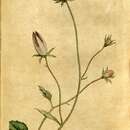en
names in breadcrumbs


Campanula carpatica, the tussock bellflower[2][3] or Carpathian harebell, is a species of flowering plant in the family Campanulaceae.
Campanula carpatica is a low-growing herbaceous perennial. Plants possess basal leaves and thin, white rhizomes. Stems grow up to 45cm long. Flowers are solitary and stand on stalks ranging from 10-15cm long. Flowers are purple in colour and plants bloom from June to August.[4]
Campanula carpatica is native to parts of Europe including the Czech Republic, Romania, Slovakia, Ukraine,[5] Poland and Western Russia.[4] It can also be found growing within the Carpathian Mountains of Central Europe.[5]
Campanula carpatica has also been introduced into areas outside of its natural range. This species was introduced further into Europe in Hungary,[5] Denmark, Belgium, France, Norway and the United Kingdom.[6] The species was also introduced into North America where it has been recorded in the states of Connecticut and Michigan.[5]
Campanula carpatica naturally grows in elevated, mountainous habitat where they grow in and amongst rocks.[4]
It was introduced to the Royal Botanic Garden at Kew in 1774 by Nikolaus Joseph von Jacquin.[7]
Several cultivars in shades of white, blue, pink and purple, have been developed for garden use.[8]
This plant has gained the Royal Horticultural Society's Award of Garden Merit.[9]
{{cite journal}}: Cite journal requires |journal= (help) Campanula carpatica, the tussock bellflower or Carpathian harebell, is a species of flowering plant in the family Campanulaceae.